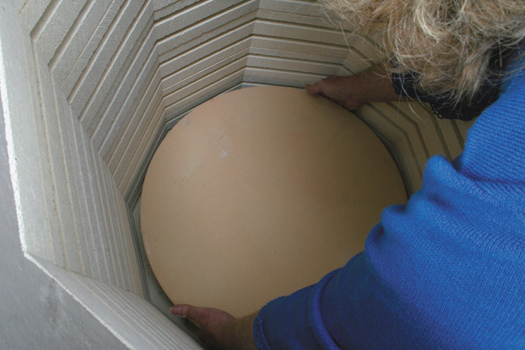 |
|
|
Kiln Pointers
|
|
|
Ceramic Firing Made Easy |
CONTENTS Ceramic Firing Made Easy Reader Response: Shelf primer on glass slumping molds; the ammeter Recent Q&As: The infinite control switch Memorable Quote ----------- CERAMIC FIRING MADE EASY These 10 basic guidelines should enable even a beginner to fire ceramics or pottery with consistent success. 1) Read the kiln instruction manual. Reading and following the manual prevents most firing problems. The time you spend reading the manual could save you many hours later. 2) Dry the ware. Firing moist greenware is hard on the kiln, slows the firing to a crawl, and often causes the ware to explode. Check for dryness by holding the greenware against the inside of the wrist. If the ware feels cool, it is not yet dry. If you cannot dry the ware fully due to high humidity, then “candle” the ware during the first few hours of firing by leaving the lid open and heat on low. 3) Load carefully. Never allow a shelf to bump against a kiln wall. Keep shelves away from the Kiln Sitter tube or thermocouple inside the kiln. Stack posts between shelves one above the other, not offset. Use kiln wash on shelves. Never use silica sand directly on the kiln bottom. 4) Use pyrometric cones on the shelf even if you use a Kiln Sitter or electronic controller. 5) Vent the kiln. Use the lid prop during the first stage of firing, or install a fan-powered vent system such as the Orton Vent Master. The ware must be vented to allow burning organics and moisture to escape. 6) Fire slowly. The thicker the ware, the slower the firing. Fast firing is a major cause of firing disappointments. 7) Monitor the kiln. Some people turn the kiln on in the evening and forget about it until the next morning when the firing is finished. They depend on the Kiln Sitter or controller to turn the kiln off. Please don’t do this. Check on your kiln near the end of the firing. 8) Do not open the lid until the kiln has cooled to room temperature. Removing the ware while it is still hot can crack the ware or glaze. 9) Keep records of every firing. Include the time that elapsed between switch settings of a manual kiln; the electronic controller program used; firing time; cooling time; firing results; and bending of the shelf cones. 10) Test constantly. Test new clays and glazes to broaden your knowledge. Use a small test kiln, or place scrap clay test pieces on the kiln shelf during your regular firings. Testing and experimenting are part of the fun of ceramics. ----------- READER RESPONSE Jamie Gray of the Calgary Warm Glass Guild in Calgary, Alberta, Canada wrote, “I'd like to offer a suggestion to the person who submitted the question about getting kiln-shelf primer off molds. First, if you're just slumping into molds, primer should last virtually forever with the very first primer coat you put on. You should not have to remove/reapply the primer unless you've taken your molds to full fire (in which case the primer will stick to and come off on the glass). If you need to remove the primer for some reason, you can try sandblasting it off.” ---------- Tony Rodriguez of San Antonio, Texas wrote, “Your Kiln Pointer states that to measure amps you need a clamp-type meter, but you showed a Fluke multimeter capable of measuring amps too. I use the same Fluke fork-type multimeter, because it is easier to read amps with it by just sliding one wire inside the teeth of the fork.” ----------- RECENT Q&As Q. Does the 1, 2, 3, 4 and 5 on the infinite switch represent percentage of time the element will stay on? i.e. 1 is 5 percent, and 5 is 100 percent? A. The numbers are not precise. The actual percentage of time at a particular setting will vary from one switch to the next. It would be easy to test the switch with a stopwatch, though. For five minutes, add the time that the elements stay on. You can hear them humming when they turn on after a clicking noise. You can also use a pyrometer to measure the heating rate at each switch position. However, that rate will vary depending on the kiln's temperature. The higher the temperature, the slower the rate. ----------- MEMORABLE QUOTE “The profound experience of working with clay is to have a three dimensional image in your head, and then have it come out through your hands.” --Marie Gibbons ----------- Would you like to appear on Paragon’s Facebook page? Send us photos of you and your Paragon kiln, ware you have fired, interesting scenes where you live, etc. I am still writing my 2010 New Year's resolutions. I will tape them to the inside of my home office door where I can see them often. Resolutions are easy to remember if we can see them every day. Thank you, With best wishes, Arnold Howard Paragon Industries, L.P. – Better Designed Kilns 2011 South Town East Blvd., Mesquite, Texas 75149-1122 Voice: 972-288-7557 & 800-876-4328 / Fax: 972-222-0646 / ahoward@paragonweb.com / www.paragonweb.com PRIVACY NOTICE: Under no circumstance do we share or sell your email address. Copyright 2010, by Paragon Industries, L.P. |
|
|

|
|
|
|
|
“Custom and standard Kilns and Industrial Furnaces for ceramics, pottery, heat treating, enameling, |
||||
